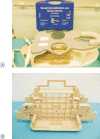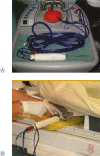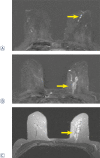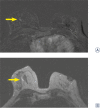Outcome of MRI-guided vacuum-assisted breast biopsy - initial experience at Institute of Oncology Ljubljana, Slovenia
- PMID: 23077445
- PMCID: PMC3472934
- DOI: 10.2478/v10019-012-0016-0
Outcome of MRI-guided vacuum-assisted breast biopsy - initial experience at Institute of Oncology Ljubljana, Slovenia
Abstract
Background: Like all breast imaging modalities MRI has limited specificity and the positive predictive value for lesions detected by MRI alone ranges between 15 and 50%. MRI guided procedures (needle biopsy, presurgical localisation) are mandatory for suspicious findings visible only at MRI, with potential influence on therapeutic decision. The aim of this retrospective study was to evaluate our initial clinical experience with MRI-guided vacuum-assisted breast biopsy as an alternative to surgical excision and to investigate the outcome of MRI-guided breast biopsy as a function of the MRI features of the lesions. PATIENTS AND METHODS.: In 14 women (median age 51 years) with 14 MRI-detected lesions, MRI-guided vacuum-assisted breast biopsy was performed. We evaluated the MRI findings that led to biopsy and we investigated the core and postoperative histology results and follow-up data.
Results: The biopsy was technically successful in 14 (93%) of 15 women. Of 14 biopsies in 14 women, core histology revealed 6 malignant (6/14, 43%), 6 benign (6/14, 43%) and 2 high-risk (2/14, 14%) lesions. Among the 6 cancer 3 were invasive and 3 were ductal carcinoma in situ (DCIS). The probability of malignancy in our experience was higher for non-mass lesion type and for washout and plateau kinetics.
Conclusions: Our initial experience confirms that MRI-guided vacuum-assisted biopsy is fast, safe and accurate alternative to surgical biopsy for breast lesions detected at MRI only.
Keywords: MRI; MRI guided vacuum assisted biopsy; breast cancer.
Figures










References
-
- Kuhl CK, Schrading S, Bieling HB, Wardelmann E, Leutner CC, Koenig R, et al. MRI for diagnosis of pure ductal carcinoma in situ: a prospective observational study. Lancet. 2007;370:485–92. - PubMed
-
- Lehman CD, Deperi ER, Peacock S, McDonough MD, Demartini WB, Shook J. Clinical experience with MRI-guided vacuum-assisted breast biopsy. AJR Am J Roentgenol. 2005;184:1782–7. - PubMed
-
- Lehman CD, DeMartini W, Anderson BO, Edge SB. Indications for breast MRI in the patient with newly diagnosed breast cancer. Indications for breast MRI in the patient with newly diagnosed breast cancer. J Natl Compr Canc Netw. 2009;7:193–201. - PubMed
LinkOut - more resources
Full Text Sources
